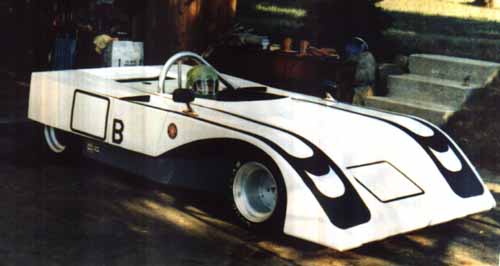
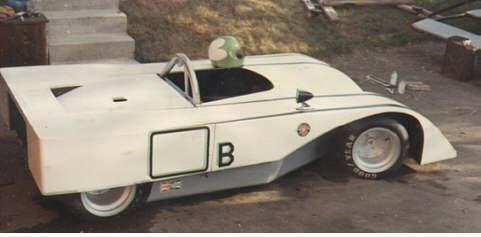
N.T.M. MARK IV
A Competitive S.C.C.A B/SR
Norcross Tabin Manufacturing built two Mark IV cars. These cars were identical and designed as B/SR cars with 2 Liter Engines for power. Both chassis are monocoque glass fiber. The only metal cast into the fiberglass is the roll bar with the rear suspension trailing arm attachment points. Chassis number 5, (S.C.C.A. roll bar designation 007 294) was completed on May 30, 1972. The wheel base is 88” with a 61” front track and a 64” rear. The weight, according to the original SCCA log book, was 980 pounds.


As delivered in 1972, the cars reflected the slab sided box design just beginning to become popular with the larger CanAm cars. As with previous N.T.M. cars, the radiator was mounted in the extreme rear of the car. Air was drawn over the rear deck and down through the radiator and out the back of the car.
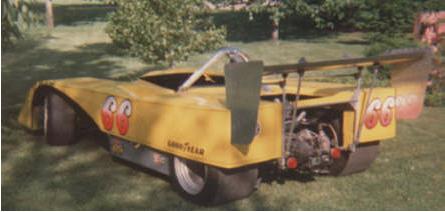 Several attempts by owners and
drivers were made to improve the Mark IV. Wings and spoilers were added in
an attempt to improve handling. Without the design and engineering
expertise of Steve Norcross and the driver / builder communication of Mort
Tabin, race car development proceeded at a slow pace.
Several attempts by owners and
drivers were made to improve the Mark IV. Wings and spoilers were added in
an attempt to improve handling. Without the design and engineering
expertise of Steve Norcross and the driver / builder communication of Mort
Tabin, race car development proceeded at a slow pace.
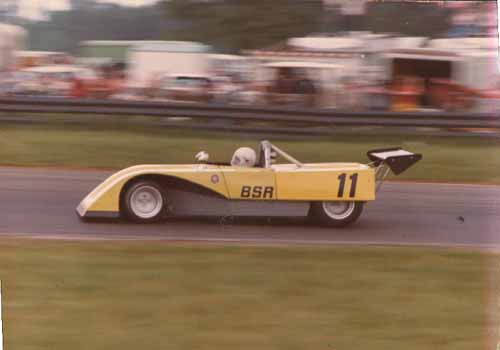
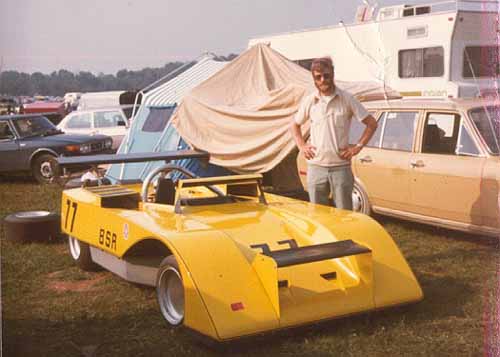
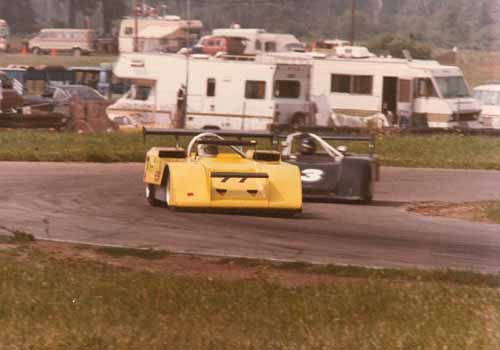
Besides adding spoilers and wings to improve handling, engine cooling remained a problem. The picture at left shows the Mark IV retaining the rear mounted radiator. The two pictures on the right show added scoops in the rear deck for twin side mounted radiators. This was an attempt to improve cooling and weight balance.
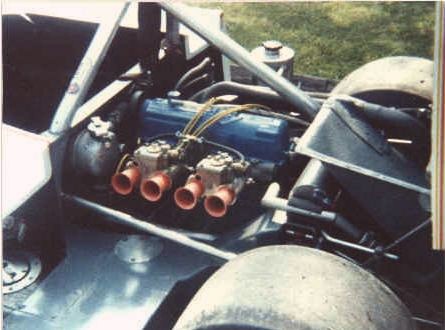 Various engine and transaxle
combinations were tried. Chassis #6 had been delivered with a BMW 2 Liter
coupled to a FT 200. Chassis #5 was delivered without an engine but with a
FT 200 transaxle. Owners tried several Ford power plants including the
tried and true Ford SOC 2 Liter with Weber carburetion.
Various engine and transaxle
combinations were tried. Chassis #6 had been delivered with a BMW 2 Liter
coupled to a FT 200. Chassis #5 was delivered without an engine but with a
FT 200 transaxle. Owners tried several Ford power plants including the
tried and true Ford SOC 2 Liter with Weber carburetion.
This car has
raced several classes including D/SR with a Suzuki
KZ1000.
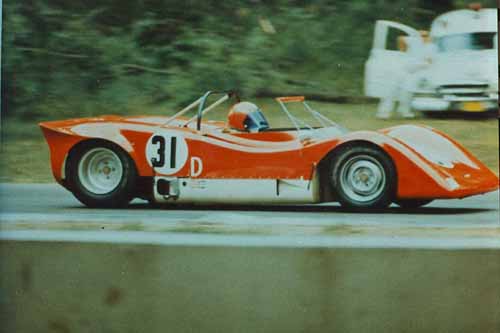 In
the fall of 1977, with Jim Predith driving, the car was crashed heavily
at Nelson Ledges destroying the body, breaking the front suspension off at the
outboard hiems joints and damaging the rear uprights.
With all this damage the monocoque
tub and Predith remained unhurt. The
original Mark IV body molds were lost in fire at N.T. Manufacturing so it was
decided to use the Mark II body as a replacement. This picture is a 1972
picture of the N.T.M. Mark II.
In
the fall of 1977, with Jim Predith driving, the car was crashed heavily
at Nelson Ledges destroying the body, breaking the front suspension off at the
outboard hiems joints and damaging the rear uprights.
With all this damage the monocoque
tub and Predith remained unhurt. The
original Mark IV body molds were lost in fire at N.T. Manufacturing so it was
decided to use the Mark II body as a replacement. This picture is a 1972
picture of the N.T.M. Mark II.
The
use of the Mark II mold remains today. Never fear, there are replacement
body parts available for the Mark IV with the Mark II
body.
N.T.M. MARK IV
A Vintage Racer
I purchased N.T.M Chassis #5 in 1993. The Ford engine and transmission had been replaced by a motorcycle engine. The car had been raced as a D/SR and finally used as a buck for Chrysler concept cars. The monocoque tub was there as was most of the suspension. The Mark II body had been removed and grafted to a Lola T440 body.
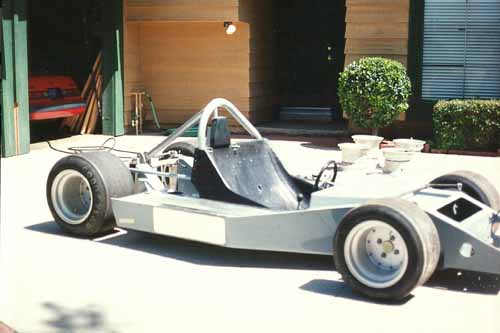
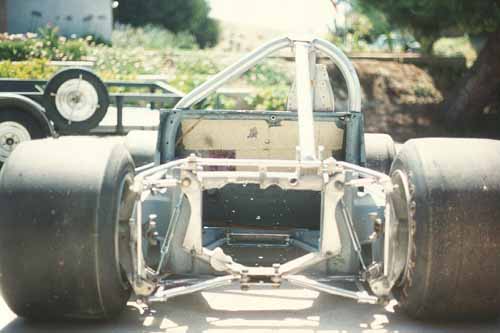
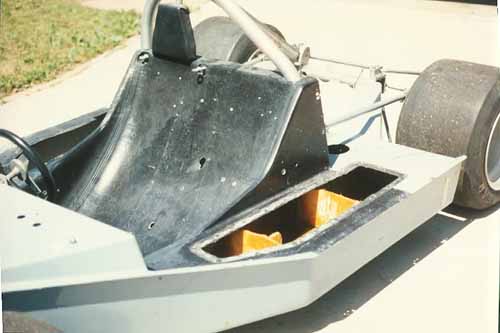
Once assembled some of the modifications were evident. Glass fiber had been cut away in the right pontoon to provide oil cooler ducting. These were covered with aluminum plates. The top of the rear hoop (the transaxle support) had been cut away to allow room for the chain drive. Holes had been drilled everywhere for mounting "this and that". Yes, that was asbestos glued to the back of the drivers seat for cooling. The picture on the far right shows N.T.M.'s fuel cell. Rigid foam partitions were made in the left pontoon. A heavy coating of butyl rubber reinforced with glass fabric was applied. Finally, foam rubber was forced into the cell.
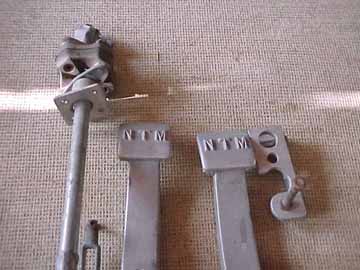 The
monocoque
tub was
cleaned, patched, repaired and painted. The fuel cell was removed.
The chassis sat in this condition for five years awaiting the body. It was
decided early on to restore the car using the Mark II body. It had
raced
with the Mark II body, the body molds were still in existence and the Mark II
body was much prettier.
The
monocoque
tub was
cleaned, patched, repaired and painted. The fuel cell was removed.
The chassis sat in this condition for five years awaiting the body. It was
decided early on to restore the car using the Mark II body. It had
raced
with the Mark II body, the body molds were still in existence and the Mark II
body was much prettier.
I
asked Mort Tabin why all the N.T.M.s had survived for thirty years. They
survived the years, before vintage racing, when an old race car was just that,
old race cars. Mort said "they were just too pretty to throw away".
The pedal assembly of the Mark IV shows the attention to detail that
guided Tabin and Norcross. The aluminum pedals have the letters
N.T.M. cast in place.
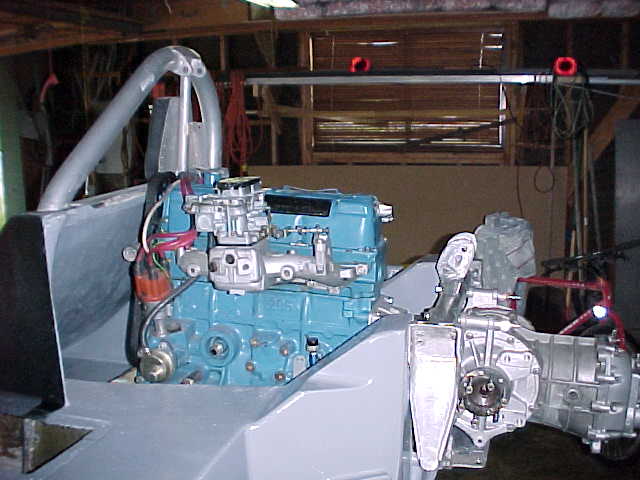
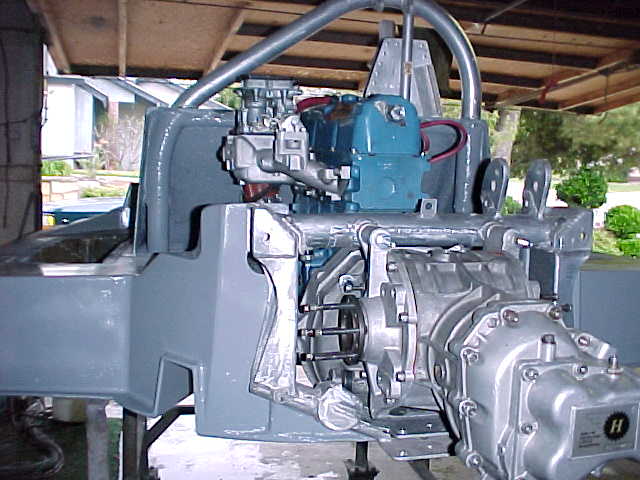
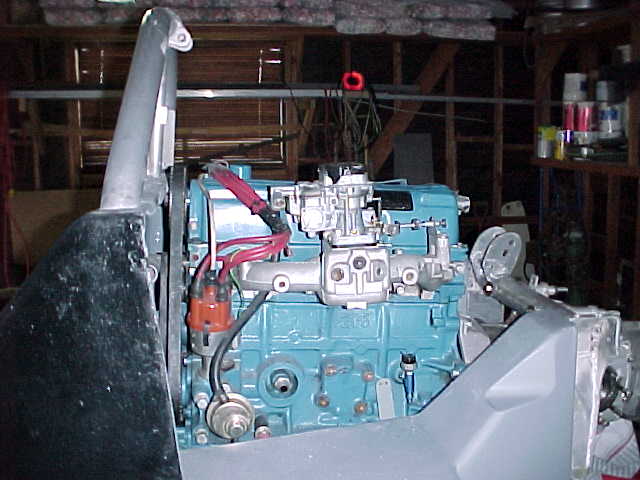
I purchased a Loyning prepared Ford SOC 2 Liter and a Hewland Mark 9 transaxle from a TIGA Spec. Racer. The engine remains unmodified from the Loyning set up. The Hewland is 4 speed with gears.
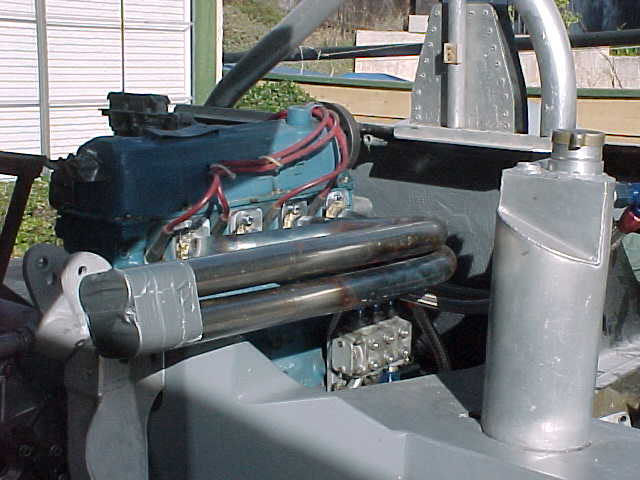
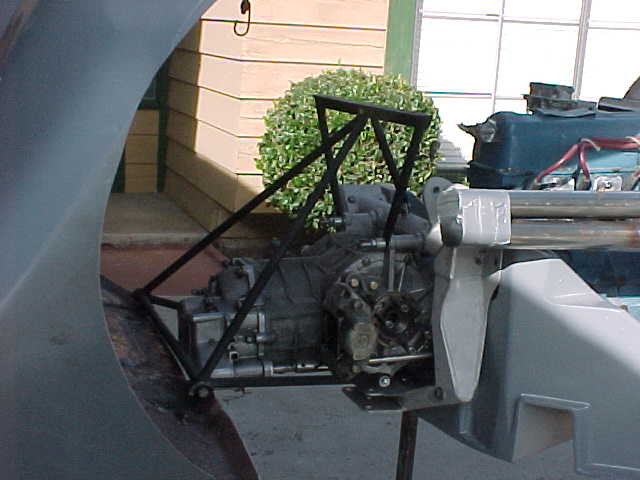
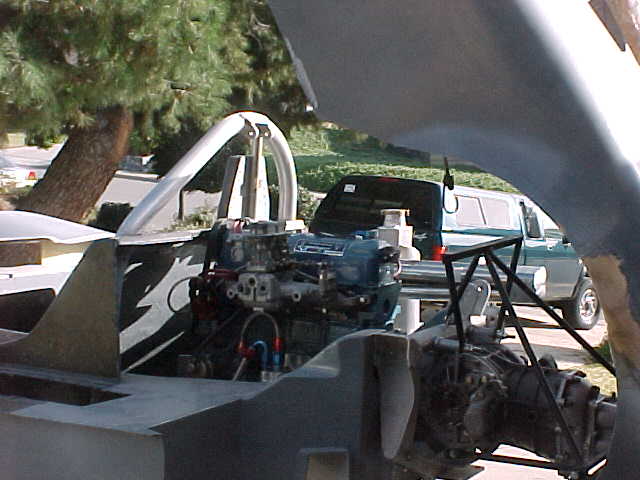
A Stahl header kit was purchased and the front and rear body supports were fabricated and installed. The dry sump system was changed to a Titan Series II and the pump was moved to the right side of the engine.
N.T.M. MARK IV
Today: For Sale
The following pictures were all taken in July, 2001. The pictures are shown as thumbnails and will enlarge for easier viewing. They shows the present condition and state of completion of the N.T.M. Mark IV. My asking price is $15,000 with all extras and spares including all historical documents and pictures. The car is located in San Marcos, California, just 25 miles north of San Diego and is available for viewing almost any time. Please contact me at:
Steve Bush
726 Brass Lantern Road
San Marcos, CA
92069
760-471-7836
sab92078@home.com
The Mark II body front and rear sections have been attached. The doors remain unattached. Some of the interior air ducting for the front mounted radiator have been fabricated. The cut out portion of fiberglass for the radiator intake is included. My intention was to take in air at the front, pass it through the radiator and exhaust it through the front section in front of the windscreen.
The brake calipers on the Mark 9 are from the TIGA S/R. There are no rear brake rotors. The original half shafts are included. Also, included is the center set up for a motor cycle chain drive.
The Titan Mark II dry sump pump was installed. The Titan Standard pump is included. More Norcross detailing is evident on the front wheel hubs.
A gear drive starter from the TIGA is included as the Stahl 4 into 1 header. Four extra wheels are included, 2 each 10" wide by 13" and 2 each 12" wide by 13". The top brake calipers shown in this picture are off the TIGA. The bottom ones are extra new front calipers that fit the N.T.M. The steering wheel and pedal assembly is included as is the clutch bracket, cylinder and rod. The brake calipers in the far right picture are off the TIGA with the original N.T.M. calipers barely visible to their right.
The radiator is custom made aluminum. The original N.T.M. brake cylinders are in the background. The three newer brake cylinders are the brake and/or clutch master cylinders off the TIGA. The shift linkage is off the TIGA with attached universal joints. Extra gears for the Hewland are included as are various tune-up parts for the Ford.
More
CAR DATA added August 26th.
Year:
Completed May 30, 1972
Make:
N.T.M. (Special, built by Norcross Tabin Manufacturing
Model:
Mark IV (B/Sports Racing Car)
Designation: Vintage Eligible Sports Racing
Project
Owner: Steve A. Bush
Address: 726 Brass
Lantern Road
San Marcos, CA 92069
United States
Owner
Phone: 760-471-7836
Owner
FAX: 760-471-7836
Owner
Email: sab92078@home.com
Manufacturer
Serial Number:
Chassis Number 5
SCCA
Roll Bar Designation:
007-294
Engine
Number:
None
Gearbox
Number:
H9-4469
Logbooks:
None
Condition:
Car
is 90% parts complete, 70% labor complete
Price:
Asking
$15,000
Location:
North San
Diego County, California
Description: Car includes
rolling chassis with body. Engine
and transaxle are mounted. Body
needs mounting of doors, completion of interior stiffening and windscreen. Transmission needs installation of shift
linkage. Dry sump and pump are
installed on engine with all oil lines but a Titan Mark II pump drive wheel and
belt are needed. Front and rear
suspension is complete with the exception of shocks and springs. Steering is complete but steering wheel
must be installed. Brakes are
complete with the exception of rear brake rotors. Clutch is complete including slave
cylinder and bracket. There are no
gauges. All hydraulic lines and
wiring must be completed.
History:
(See description of Mark IV, Chassis #5 for car that is for sale on
eBay!)
EVERYTHING YOU’VE ALWAYS WANTED
TO KNOW ABOUT N.T.M.
But Were Afraid To Ask
The principals of Norcross Tabin Manufacturing were Steve Norcross and Dr. Morton Tabin. The two met in July of 1967 at an autocross. An interest in cars brought Norcross and Tabin together and a loose partnership was formed while spectators at Indianapolis Raceway Park. The first partnership, potentially including Chuck Ulinski, was to be named “TEAM N.U.T.” (TEAM Norcross Ulinski Tabin). Dr. Tabin, a psychiatrist, didn’t approve of the name “for professional reasons”. Eventually, Ulinski was dropped from the venture and the N.T. Manufacturing (Norcross-Tabin-Manufacturing) venture was begun.
The two agreed their first venture would be
a D/SR car of fiberglass monocoque design similar to the Chaparrals of
Jim Hall. Steve Norcross was the principal
designer and constructor with a strong background in
automotive suspension design and glass fiber
construction. Dr. Mort Tabin filled
the role of driver and principle financier. What would make N.T.M. sports racing cars different, and
still unique about all N.T.M cars,
was they were built using “cheap” resins and
reinforcements. Plain fiberglass
and polyester resin, the same products used by boat manufacturer’s, were used. Colin Chapman’s Lotus Elites and Elans
also took this approach rather than the expensive epoxies used by
the Chaparrals. The concept was to build a no
nonsense race car without using unobtainable (Products called “unobtainium” by Bruce
McClaren.), exotic and/or expensive products.
Beginning in 1969 N.T.M. built seven sports racing
cars: one Mark I, two Mark II’s, two Mark III’s and two Mark IV’s. All cars were built as D/SR cars with
the exception of the Mark IV’s, which were built for B/SR.
Late in
1975, NT Manufacturing sold all the sports racing drawings, molds, parts
(including a third Mark III tub) and productions rights to
Chuck Ulinski and Bob Reeser of Champaign, Illinois. Ulinski and Reeser started NTM
SPORTSRACING CARS offering Mark
II, III and IV kits and
completed cars. As of August 1976
NTM Sportsracing “sold and
delivered one, have another available immediately and have one under
construction”. Literature dated
10/18/76 indicates NTM
Sportsracing had for sale a
Mark IIIB (Chassis #6) with a Honda 750 installed and a Mark IIIB (Chassis #5)
to be built to the customers specifications. It is also assumed Ulinski did not build
any cars and “sold and delivered one” was
the Mark III (chassis #2) built by N.T. Manufacturing and sold to
Harry Stewart of
Nevada City, California. The “another
available immediately” car was the blue Mark II purchased from N.T.
Manufacturing and presently
owned by George Brown. The “one under construction” was probably
based upon the uncompleted Mark III
tub purchased from Norcross,
also built by
N.T. Manufacturing,
(chassis #5?), sold to Butch Moses. Ulinski appears to have provided his own
chassis numbering system using a
“B” designation and numbering these last two Mark III D/SR cars chassis
#5B and chassis #6B. These chassis should not be confused with the
B/SR cars, chassis #5 and #6.
Steven Norcross entered the commuter car market with STEVE
NORCROSS DRAGONFLY CARS in
Urbana, Illinois. The first prototype DRAGONFLY was powered by a
Koher snowmobile engine producing 93
hp and an estimated 40
mpg and variable ratio, via
V-Belts, transaxle. The wheel base
was 88” and the track was 52”. The weight was 1250 pounds. The projected selling price of the
DRAGONFLY was “under $4000.
After 2250 miles of
testing it was determined that the 67 mph top speed
was insufficient and a new engine
and transaxle combination would have to be tried.
Ulinski and Reeser sold the remains of their venture to George Edis in South Carolina. Mr. Butch Moses of Henderson, North Carolina and Mr. Chip Haddock purchased
these parts, original shop drawings
and chassis and molds for the Mark II and III with the intention
of reproducing the cars, using exotic carbon fiber technology, for modern SCCA racing. A SCCA ruling prohibiting the use of
carbon fibers construction put an end to
this project. Moses now has these parts and a complete
Mark III chassis and body built by N.T. Manufacturing and, until recently, the “factory” Mark II.
THE MARK I
During the first months of
1968 the one N.T.M. Mark I was constructed. It was raced as the “factory” car,
driven by Dr. Tabin, and used as
the prototype for the Mark II’s. The chassis was a
fiberglass monocoque tub, bulkheads, pontoons, gas tank, and
seat with a aluminum roll bar. A
rear aluminum subframe bolts to the
fiberglass chassis at
the roll bar and carries the engine mounts and rear suspension. The front suspension is carried on
large aluminum surface
brackets bolted to pockets in the tub.
The track is 48”/front and 47”/rear. The wheel base is
78”. The brakes were Airhart. The original power was a three cylinder
two stroke 850 cc SAAB coupled
to a Webster transaxle. The original color was red gelcoat and cream
gelcoat. None of the cars was
ever painted. The bodies
weighed about 53 pounds being hand lay ups of one layer of ¾ ounce per
square foot mat and one layer of 6
ounce per square yard cloth
finished to a thickness of .045 inches thick.
The
first outing of the Mark I occurred late in the 1968
season at Waterford Hills in the rain.
No drain holes had been provided in the tub and the car filled with
several inches of water. According
to Tabin, the inertial effect on
braking, acceleration and
cornering left much to be desired.
Drains were added before the second race. Tabin and Norcross had become friends of Larry Schneider and his partner,
Gene. Their car, an
Ocelot, had been heavily crashed towards the end of the 1968
season but because of their divisional points advantage they had been invited
to the ARRC at
Riverside. Larry and Gene asked to use the N.T.M. and
fitted one of
their SAAB engines. Ron Dennis, their driver and driving with a broken ankle,
suffered many mechanical problems and the car failed to
finish.
Jim
Leach, a “Professor” at the
University of Illinois, joined the N.T.M. team. Jim had never attended college but had become an expert in casting technology. In his personal foundry, in his back
yard, the front suspension uprights,
rear hub carriers, steering
box and pedals were cast from an alloy called Tinsalloy. According to Jim, Tinsalloy is an alloy
of aluminum which is age hardened,
the older it gets the stronger it gets.
Norcross now proceeded with the redesign of the Mark I. According to Norcross, “The redesign of
the Mark I included all new suspension, a major number of tub
modifications, new doors and the addition of a spoiler to
the rear body panel. The front body section was the
only thing I left alone. Jim Leach
had done hub carriers for the Mark I,
but since they didn’t work out with the new
suspension geometry, they were
scrapped and new patterns made along with front spindles, steering box
pedals, little hub caps plus some other stuff that I’ve forgotten, probably because it didn’t work
out.
During the winter of 1969/70 N.T.M. sold
the Mark I to Dick Johnson. Johnson
wanted to race D/SR using a Honda
750. NTM undertook the
modifications which included replacing the rear of the fiberglass tub structure
with a steel tube subframe, replacing the rear suspension with Mark
II components, modifications to the front tub and painting the car purple. Johnson raced the car for the next
season. NTN got the car back
because of the money still owed.
In 1971 NTM sold the Mark I to Eleanor Morris of
Watervlist, New York and
Karl Danneil. Both Morris and Danneil were drivers of the car. The car was painted purple when it was
sold to Morris. The Mark I
qualified for the SCCA National Championship Runoffs in 1974, 1975 and
1976. In 1976 both Morris and Danneil earned Northeast Division invitations to
Road Atlanta with the same car.
Danneil was a DNQ at
the Atlanta event in
1976 with a
best time of 1:51:76 before an off course excursion damaged the right front. On August 11, 1973 in the Harold Jacque Memorial at Watkins
Glen. Ms. Morris’ qualifying
time was 1:57.8 compared to 1:37.8 for Tabin in the Mark
III.
Ms.
Morris did not repair the car after the Atlanta wreck and stored the car
until 1989. In 1989 she sold the
Mark I to Greg Rickes of Latham,
New York.
In
1992 Rickes sold the car to Kirk Buecher and Leonard
Arnold of Greeley, Colorado. The
restoration was completed in early 1997 using a non-Honda 833cc motorcycle
engine. The car now has a full SCCA
type roll cage and is blue in color.
In early 1997 the car was for sale for $13,000.
THE MARK II
The intention of the design of the Mark II was to “win D/SR
races in the Midwest Region of
S.C.C.A.”. Midwest
Region was the “absolute hotbed of D/SR competition in the United
States” in the late 1960’s. To this end two N.T.M. Mark II’s were
constructed. The dates of
construction are unknown. The
factory car” was red and campaigned as #31. The original power was again the SAAB
850. The construction dimensions were the same as the Mark I. Sometime during
the 1969 season Mort Tabin decided
the Honda S-800 was the best choice of engines and he managed to
purchase one from Hal Needham.
Norcross proceeded to
mate the Honda S-800 with a Webster/Hewland Mark VIII
and replace the SAAB. According to
Norcross, “The S-800 conversion was fairly straight forward with the
exception of the exhaust system, which altogether had nine feet of
tubing and was a
true bundle of snakes. It
was actually the same system that the
front engine Yoshimura S-800 sports car used. We were afraid to change it because of
the potential loss of power and we didn’t have a dynamometer at the time. The other problem was with the clutch
disk. I could see no way to adapt
the Honda disk to the VW
transmission shaft. What we
wound up doing was to
install the center spline fitting from a VW disk into a
7 or 8
inch diameter metal cutting saw blade and then removed the
facing from the Honda clutch disk and reinstalled it on
the modified saw blade. We
used that same clutch disk for all the racing, in both the Mark II and Mark III
factory cars.
Toward the end of the 1969 season Tabin purchased a new Yoshimura Honda S-800 and an enormous amount of spare parts. Knowing the “old” S-800 couldn’t beat the Central Division competition, the new engine was installed. The first outing for the new engine was at Savannah. Tabin had a great race with Don Ramsey with both drivers lapping the field. Tabin won on the last lap. The next race was at I.R.P.. The engine blew in practice. It was shipped back to Japan where Pop Yoshimura repaired it.
The Mark II finished the 1969 season in a tie third place for Central Division D/SR. Both Ramsey and Tabin were invited to the ARRC where Tabin finished second, using the old engine, to Marv Thompson’s Bobsy/Sunbeam, also from Central Division.
About this time, Steve Gilbert and Gary Voss joined the NTM crew. Both were students at the University of Illinois. Steve was an engineering student and loved engines. Gary was studying art. Both worked hard and unpaid.
After initial sorting problems the Mark II began to win races in the 1970 season. By the time they entered Mid-Ohio they had won three straight. Oil overheating problems caused Tabin to elect to DNF rather than ruin an engine. The chief competition again came from Don Ramsey in his home built “O”, the factory Ocelot and Bob Snider also in an Ocelot. Marv Thompson had moved on to another class. Tabin finished 4th in the Central Division and 2nd at the ARRC in 1970.
In 1971 Tabin scored a perfect 54 points in the Central Division, six wins out of seven races, and qualified but DNS at Atlanta.
This car has been converted to Kawasaki Motorcycle power by Butch Moses of Henderson, North Carolina. The Mark II was purchased by Dr. Paul Meis, a Honda S-800 vintage race driver, of Winston-Salem, North Carolina and was restored by Peter Kraus of Kraus & England using a S-800 coupled to a Webster five speed transaxle. The car is currently white with a gray tub and is being campaigned in S.V.R.A. with Dr. Meis driving. Dr. Meis is also the owner of the Mark II body molds.
The “second car” was sold to Chuck Ulinski of Champaign, Illinois. The color was blue and remained powered by the 750 Honda. This car campaigned in SCCA D/SR until recently and is currently powered by a Suzuki and has been sold by Steve Linn to George Brown of Lahaina, Hawaii. This car is in Colorado and has recently been campaigned in Rocky Mountain Vintage races. After two unsuccessful outings destroying two Suzuki engines, the car converted to 1600 power coupled to a Hewland 5 speed transaxle.
Two Mark III’s were built by Norcross. One additional Mark III was completed by Uliniski. The chassis was completely fiberglass monocoque with the rear aluminum subframe removed and the rear suspension and engine mounts carried on the fiberglass tub. It was a totally “new” car and much smaller than the Mark II. The body presented a totally new look also reflecting the “slab side” design of current CanAm cars. The track was 44 inches front and rear with a 75 inch wheel base. According to Tabin, “the whole concept of the Mark III was to keep frontal area to an absolute minimum. The Mark II was a much better handling car and a dream to drive while the Mark III was much faster on the straights but unpredictable in the turns.” Tabin used the words “scary” and “twitchy” in describing the Mark III handling.
N.T.M. Chassis #2, the “factory car”, was completed April 1, 1972. The original body color was red with a gray tub and the number was 30. This car was taken to, but not qualified, the Atlanta run-off’s in 1972 where it was wrecked badly in the left front due to vibrations caused by misalignment of the rear drive shafts. The handling was not as good as the Mark II but it was faster. At that time the car was geared for a 145 m.p.h. top speed and had no trouble gaining top R.P.M. n 5th. gear.
The track was then increased to 46”front and rear by adding 1” spacers at each wheel on the “factory car” to improve handling. A 1 ½” addition was made to increase the width of the tub between the wheels on both sides. A new wider body was made and it was painted white.
On August 11, 1973 the Mark III was qualified by Tabin for a SCCA National with a 1:37.8 at Watkins Glen and then set a new D/SR fast lap record of 1:30.4 or 96.69 mph. William Green, Historian of Watkins Glen International confirms this record still stands for the “pre chicane” course and the N.T.M. is still listed in the Watkins Glen record books. Since the chicane was removed again the present D/SR record was set in 1985 by Michael Weir in a Weir III at 1:29.48.
Chuck Ulinski became the owner of Chassis #2 in 1975 purchasing it from N.T.M.. In 1977 it was sold to Harry Stewart of Nevada City, California by Chuck Ulinski. Stewart, a Datsun car dealer, removed the Webster transaxle and S-800 engine with the intention of installing a Datsun engine and race C-Sports Racing. The engine was sold to Norm Hart, a San Francisco area D/SR builder and racer. The engine was used in Hart’s Honda/Elva. About a year later, seeing that the engine bay was an impossible fit for the Datsun, Stewart sold the car to Dick Steihert of Spring Valley, California. In May, 1987 Steihert sold the car to Steve Bush of San Marcos, California. There was no engine or transaxle but a Honda S-800 engine coupled to a Webster 5 speed was original N.T.M.. The roll bar was symmetrical with two braces. The radiator was rear mounted over the transaxle. This car was restored in the “wider” configuration by Steve Bush of San Marcos, California using the original S-800 purchased from Norm Hart.
Bush sold the Mark III in April, 1993 to Dave Dexter. Dexter sold the car to Ken Cottrell of Lilburn, Georgia. In June, 1995 Doug White of Winston-Salem acquired the car from Cottrell.
One of the other Mark III’s, chassis #5 (?), was completed with a asymmetrical roll bar with one brace and is owned by Butch Moses.
The third Mark III was destroyed in a fire in a barn according to Moses. Parts of this car were removed by Moses. This was the third Mark III built by N.T. Manufacturing and never completed by N.T. Manufacturing of NTM Sportsracing.
Another Mark III, built about 1980 by Chip Haddock, is owned by Rob Henley of Charlotte, North Carolina. According to Moses, this car “is much heavier than the original N.T.M.s”. Presently the chassis and suspension are FOR SALE. Henley is keeping the narrow body for a SCCA D/SR project.
The MARK IV
Two
B/SR cars were built for customers.
These cares were designated Mark IV’s.
N.T.M. Chassis #6, a B/SR
car, was completed June 3, 1972. It
is currently owned by Dereck Harling of Windsor, Ontario. The wheel base is 88” with a 61” front
track and a 64” rear. The weight,
according to the original SCCA log book, is 980 pounds. N.T.M. built this car and sold it to
Bill Roush. The original engine was
a 2 liter single cam BMW but it was changed to a Cosworth BDD and then to a
Hart. The transaxle was a Hewland
FT 200. Roush sold the car to
Dennis Clopper who sold it to Don Woodruff who sold it to Mike Major. Major removed the Cosworth and the
Hewland and started converting the B/SR car to a D/SR car using a motorcycle engine. Strebig purchased the car from Major. In November, 1998, Derek Harling
purchased the car and is intending to restore it for vintage racing.
N.T.M. Chassis #5 (S.C.C.A.
roll bar designation 007 294) was completed on May 30, 1972 and sold to Dr.
Quinn Calhoun of Chicago. Calhoun
became a Sports 2000 driver from the Detroit Region. He resold the car without racing it to
Mr. Joe McRoberts, then powered by a Cosworth 1800 BDE. Again, after never racing it, McRoberts
sold it to Mr. Jim Predith in April 1975
Predith raced the car with the Cosworth 1800 BDE and a Hart BDF engine in
S.C.C.A. out of the Detroit Region.
Predith determined the major shortcomings of the car were braking, not
getting the tires up to racing temperature and engine cooling. In an attempt to solve these problems he
replaced the rear mounted radiator with two side mounted V.W. radiators, ducting
the hot air onto the rear tires, a successful attempt to get the tires up to
racing temperature and provide the additional cooling. Predith also determined the front brakes
were “marginal, only lasting 15 laps at Elkhart Lake”. He later determined the brakes were
wearing because of the brake pads
did not pull back from the rotors due to spindle flex. The car was crashed heavily at Nelson
Ledges in the fall of 1977 destroying the body, breaking the front suspension
off at the outboard hiems joints and damaging the rear uprights. With all this damage the monocoque tub and Predith remained unhurt. Predith sold the car, after the wreck,
to Ed Murray who removed the FT200 and the Ford, reconfiguring it with a 1000 cc
Suzuki engine for D/SR. Murray also
fitted the car with a Mark II body, purchased from Steve Norcross. In this configuration it held a lap
record at Waterford Hills. Murray
sold the car to an unknown subsequent owner who sold it to Chrysler Corporation
of Detroit, represented by Darrel Morley of the Chrysler Design [Styling to the
old fashioned guys] Office. They were investigating various low cost sporty
concepts to rev up the Plymouth image.
With budgets being extremely tight in the early 80's Darrel suggested
buying the NTM tub as an appropriately sized, ready made, drivable buck for
styling mock-ups. The Design team bought the tub and a standard KZ1000
engine. The owner kept the racing
engine and Darrel Morley bought the Mk2 body! Morley mated the Mark II N.T.M.
body to a Lola T440 FF. Chrysler
moved the car to their Chrysler Pacifica operation in Encinitas, California in
1986. Chrysler Pacifica removed the
engine and used it in some developmental work. Larry Nelson bought the car from
Chrysler Pacifica in 1987. Wayne
Mitchell bought the car from Nelson in 1993 and immediately sold it to Steve
Bush of San Marcos, California.
Bush intends to restore the car with Ford power and the Mark II body.
Engine:
Loying prepared Ford Sports 2000 engine. Engine remains class legal for Sports
2000. Engine was removed from a
running TIGA Sports 2000 and condition is unknown but there is no reason to
believe there is any problem.
Fuel
System:
Ford Class Legal mechanical pump on engine. There is no fuel cell. Fuel lines are not complete.
Oil
System:
Standard Titan pump which mounted low on the left side of the engine of
the TIGA was replaced with a Titan Type II, mounted slightly higher on the right
side. Oil lines, dry sump and tank
are complete. Pump pulley and belt
are needed. Titan Standard pump and
all brackets are included.
Water
System:
An aluminum radiator has been fabricated and is included. It must be mounted and water lines
installed.
Electrical:
Standard Sports 2000 ignition is included. Coil is included as are extra Ford
ignition parts. There are no gauges
or wiring.
Gearbox:
Hewland Mark 9. Four speed
gears installed with some extra gear sets.
Body:
Body is N.T.M. Mark II body. New and needs finishing. Body molds are available for use by
others.
Chassis:
The chassis is a
fiberglass monocoque tub,
bulkheads, pontoons, gas tank, and seat with a aluminum roll bar. A rear aluminum subframe bolts to
the fiberglass chassis at
the roll bar and carries the engine mounts and rear suspension. The front suspension is carried on
large aluminum surface
brackets bolted to pockets in the tub. The wheel base is 88" with a 61" front
track and a 64" rear. The weight,
according to the original SCCA log book, was 980 pounds.
Dampers:
Aged SPAX units and must be replaced.
Springs:
Some
springs included.
Suspension:
Suspension is as last raced and should be disassembled for
inspection. Suspension is 100%
complete.
Brakes:
The original front brakes are intact, including original calipers and
disks. Also included is a second
set of new front brake calipers.
The rear brakes are attached to the Hewland and are not original. There are no rear brake rotors.
Steering:
The steering is complete.
The rack and pinion was fabricated by N.T. Manufacturing.
Wheels:
All wheels are aluminum two piece.
Two 12" wide by 13" diameter and two 10" wide by 13" diameter are on the
car. Four other wheels of the same
size are not mounted and included.
Weight:
According to the SCCA log book of the sister car, the weight, ready to
race, was 980 pounds.
Interior:
The seat is an integral structural part of the car and is in place. There are no gauges, restraint or
fire system.
Spares:
Spares and uninstalled parts are mentioned in the above descriptions.